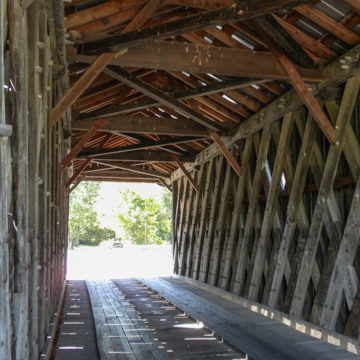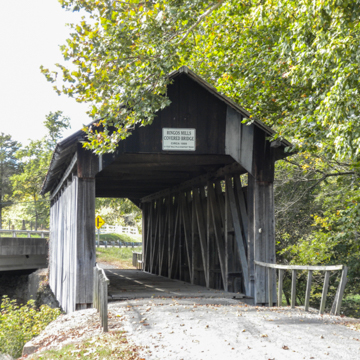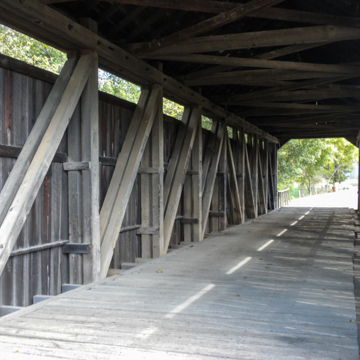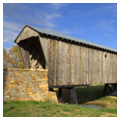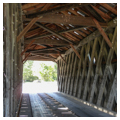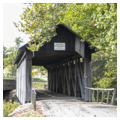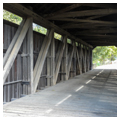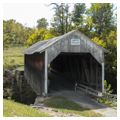You are here
Goddard Covered Bridge
Of the estimated 700 covered bridges that once stood in Kentucky, only thirteen survive and three of these are in Fleming County. The Goddard White Covered Bridge is the only bridge of the Ithiel Town lattice through-truss type in the state. The bridge is made up of dark square lumber; the massive lower and upper cords run the length of the bridge and are sistered to the smaller dimension diagonals or lattice through truss using wooden pegs known as trunnels. The camber, or rise, built into the 63-foot-long structure is very slight. A new roof, siding, floor beams, and stringers were installed in 2004–2006.
Covered bridges survive in Kentucky in Bourbon, Bracken, Fleming, Greenup, Lewis, and Washington counties. Jacob Bower, founder of Bower Bridge Company of Flemingsburg and later of Maysville, erected the 124-foot-long Colville (in Bourbon County) Covered Bridge in 1877 using a multiple Kingpost truss. His son, Louis Bower, restored the bridge in 1913, which was again restored in 1937 this time by his grandson, Stock Bower, who is remembered as the last of the Kentucky covered bridge builders.
The longest surviving covered bridge in Kentucky is the 1865 Beech Fork bridge in Washington County, which is a double Burr arch truss covering a bridge 258 feet long. Bennett’s Mill Covered Bridge in Greenup County dates from 1875 and is a Wheeler truss, while the nearby Old Town Covered Bridge, stretching 190 feet, is a Kingpost truss dating from 1870. The Walcott covered bridge in Bracken County was originally constructed in 1824 and reconstructed in 1880; it is a Kingpost and Queenpost truss bridge. The Cabin Creek Covered Bridge of 1867 is also a Kingpost truss and is 114 feet long. The Johnson Creek Covered Bridge dates to 1862 and is a Smith truss that is 110 feet in length. The 120-foot-long Switzer Covered Bridge, first built in 1855 using a Howe truss, was entirely rebuilt after a collapse in 1997.
Within sixteen miles of the Goddard White Covered Bridge are two disused covered bridges; Ringo’s Mill (1868) and the Hillsboro Covered Bridge (1868), both of which are multiple Kingpost truss systems and both measuring 86 feet in length. Just to the north in Mason County are the Dover Covered Bridge (1835), which is a modified Queenpost truss measuring 60 feet, and the Valley Pike Covered Bridge (1864), which is a Kingpost truss measuring 24 feet.
The Goddard White Covered Bridge leads directly to the Goddard Methodist Church and cemetery, the combination of which have made it the most photographed covered bride in Kentucky. It is accessible to automobile traffic and is the site of the annual Covered Bridge Festival in August.
References
Johnson, John, “Goddard ‘White’ Covered Bridge,” Fleming County, Kentucky. National Register of Historic Places Inventory-Nomination Form, 1975. National Park Service, U.S. Department of the Interior, Washington, DC.
Laughlin, Robert W.M., and Melissa C. Jurgensen. Kentucky’s Covered Bridges.Charleston, SC: Arcadia Press, 2007.
Writing Credits
If SAH Archipedia has been useful to you, please consider supporting it.
SAH Archipedia tells the story of the United States through its buildings, landscapes, and cities. This freely available resource empowers the public with authoritative knowledge that deepens their understanding and appreciation of the built environment. But the Society of Architectural Historians, which created SAH Archipedia with University of Virginia Press, needs your support to maintain the high-caliber research, writing, photography, cartography, editing, design, and programming that make SAH Archipedia a trusted online resource available to all who value the history of place, heritage tourism, and learning.













